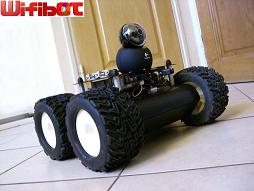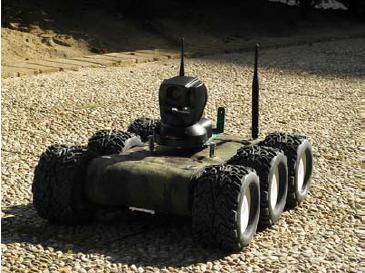A pilot plant at a winery not only generates electricity, it heats the water.

Tuesday, December 21, 2010
Solar Arrays Do Double Duty
Labels: chemistry, chimical, chimie, concept, Duble Duty, electrical, electricity, energie, engineer, engineering, solar systems, technology
Turbines Could Tap the Mississippi's Power
 The proposed development is one of a number of "hydrokinetic" projects in the works. Such projects seek to generate electricity from wave movement, tidal flows, or river currents, without the use of dams.
The proposed development is one of a number of "hydrokinetic" projects in the works. Such projects seek to generate electricity from wave movement, tidal flows, or river currents, without the use of dams.Friday, July 9, 2010
French Manufacturer of wireless robotic platforms






Nous sommes une entreprise française spécialisée depuis 2003 dans les robots mobiles WIFI pour l'éducation,
la recherche et la défense sous Linux et Windows Xpe SP3.
We are a french company working in mobile robotics and specialized since 2003 in low cost, wi-fi enabled,
multi-purpose platforms running Linux or Windows XPe.
WiFiBoT comes to fill the gap between the simple toys and the sophisticated but
expensive robots that can be found today in the market. In our platforms you will find
the right compromise between cost and sophistication so you don’t overshoot your
needs with any complicated gear.
Sunday, March 28, 2010
Robonica Launches Roboni-i, Marking the Rise of Robotic Gaming
Robonica (http://www.robonica.com), a South African/U.S. start-up focused on developing new forms of robotic entertainment, announced the launch of Roboni-i. Fusing elements of robotics, R/C vehicles and interactive gaming, this revolutionary product will create a brand new entertainment category dubbed “Robotic Gaming” by delivering meaningful and structured gameplay - whether alone, with friends or online. Roboni-i is now available online at Robonica.com, ToysRUs.com, Amazon.com, BarnesandNoble.com and also at retail in Hammacher Schlemmer, Edmund Scientific and other specialty shops for the suggested retail price of $249.99.

“Robotic gaming is the future of the home entertainment industry,” said Robonica Inc. President/Director Tom Dusenberry, the founder and former CEO of Hasbro Interactive, who is in charge of the strategic direction for Robonica as well as the company’s Global Marketing Operations. “Using state of the art technology, Roboni-i delivers instant mass appeal that will elevate robotic entertainment to a new dimension. This product is the evolutionary ‘next step’ for entertainment robotics.”
A smart, fully programmable and highly agile two-wheeled robot, Roboni-i is the first entertainment robot to offer unlimited play patterns. The state-of-the-art robot features 16 sensors and four processors, RF (ZigBee) remote control and peer-to-peer protocol allowing for competitive gameplay with real-world robots. It also comes packaged with game accessories and six action games enabling players to lay out a playing field and use the gaming controller to select a game as they enter a new dimension of interactive, real-world robotic gameplay. Whether alone or with friends, they will need to beat the odds, race against time, manage resources, neutralize threats, execute special effects and collect bonus points to improve score.

The Roboni-i’s online universe, slated to launch its beta version in November, will be out of this world. By plugging Roboni-i into the PC, players will enter a virtual world where they can earn a virtual currency, participate in virtual missions, play online games and interact with friends who are online at the same time. Its Advanced PC-based Command Center Software will allow users to program every facet of the robot’s behavior, download games and upload performance data.
FUJISOFT Releases Humanoid Robot “PALRO”
FUJISOFT Incorporated has announced the successful development of a compact humanoid robot with integrated intellectual systems. Called “PALRO,” a model of the robot will be available for educational institutions from Monday, March 15, 2010.

FUJISOFT has been researching robot technology as part of its participation in the robot intelligence development project initiative of the Ministry of Economy, Trade and Industry. The Company blended technology that it had acquired through built-in software development over the years with intelligence technology to develop PALRO®.
PALRO® is a 39.8-centimeter-tall, 1.6-kilogram humanoid robot, which combines communication intelligence that enables a spontaneous conversation with humans and mobile intelligence for autonomous locomotion. The name PALRO® is derived from a combination of “pal,” meaning “friend,” and “ro,” the first two letters of “robot.”
PALRO is equipped with a software platform permitting extensive functional enhancements. For example, it can be developed as a personal home concierge who provides a user with information and services. The application was developed using open architecture, and a dedicated library is available to support functional enhancement.
Although FUJISOFT is ultimately targeting a broad range of customer segments, from robot lovers to students and seniors, FUJISOFT will first release a model for educational institutions, specifically facilities with advanced curricula needs. FUJISOFT seeks to contribute to the development of technologies in Japan by first providing young engineers at educational institutions with robot technology as a learning material.
A model for general consumers is scheduled to be released during FY2010.
FUJISOFT will continue to develop new solutions focused on intelligence technology.
Search
Categories
- chemistry (1)
- chimical (1)
- chimie (1)
- concept (1)
- Duble Duty (1)
- electrical (1)
- electricity (1)
- energie (1)
- engineer (1)
- engineering (1)
- solar systems (1)
- technology (1)


